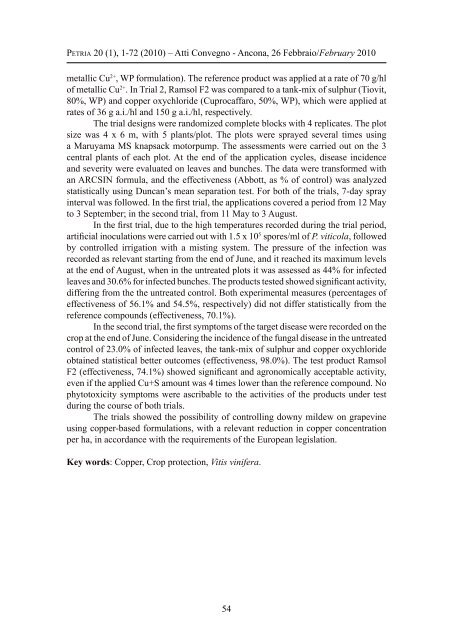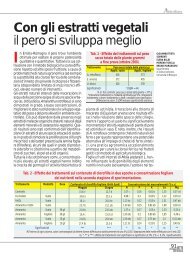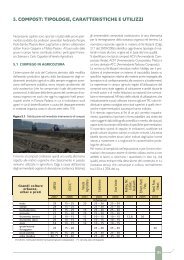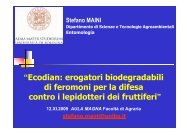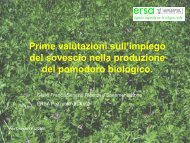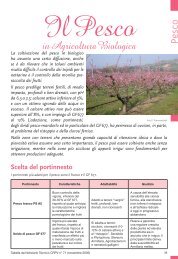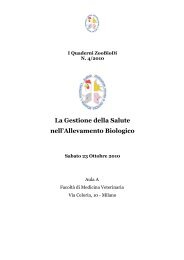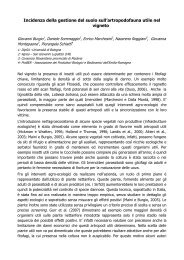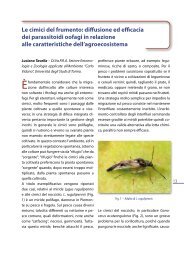Petria - “Dosi ridotte di rame e prodotti alternativi per la difesa antiperonosporica”Nella prima prova, a causa delle alte temperature registrate nel corso dellastagione si è provveduto alla inoculazione artificiale con una concentrazione dispore di P. viticola pari a 1,5 x 10 5 /ml e alla irrigazione controllata. A seguito delleripetute irrigazioni e inoculazioni artificiali la malattia si è sviluppata rapidamentea fine giugno e con discreta virulenza sulle foglie (44%) e sui grappoli (30,6%). Altermine della prova, il 23 agosto, tutti i prodotti hanno mostrato una significativaattività, rispetto al testimone non trattato. I formulati in prova (56,1% e 54,5%) non sisono differenziati statisticamente dallo standard di riferimento (70,1%), anche se sonorisultati lievemente meno efficaci.Nella seconda prova, i primi sintomi di peronospora sono comparsi nell’ultimadecade di giugno. A fronte di un’incidenza dell’infezione fungina nel testimonenon trattato pari al 23,0% di foglie colpite, i risultati ottenuti hanno mostrato che lamiscela estemporanea di zolfo e rame ossicloruro è risultata statisticamente la piùefficace (efficacia del 98,0%). Tuttavia, il formulato Ramsol F2 (efficacia del 74,1%)ha esercitato una soddisfacente attività pur apportando un quantitativo di rame e zolfo4 volte inferiore. Nessun effetto fitotossico è stato rilevato in entrambe le prove.Le prove hanno complessivamente dimostrato la possibilità di contenere laperonospora sulla vite con formulati rameici riducendo sensibilmente la quantità dirame per ettaro e rispettando i limiti imposti dalla normativa europea.Parole chiave: Difesa, Rame, Vitis vinifera.Field studies to evaluate the control of grapevine downy mildew with twoformulations characterized by low copper concentration, to reduce theapplication rates of metallic copperFor several years, the field experimental activity has been oriented towardsobtaining a significant reduction in the amounts of copper used for crop protection.This is true especially for the grapevine, in accordance with European legislation andthe concepts of organic agriculture. During 2003-2004, two experimental field studieswere carried out on grapevine, with the aim to determine the fungicide effectiveness oftwo copper formulations (Glutex Cu 90 and Ramsol F2) against Plasmopara viticola,the agent of downy mildew. Both formulations are characterized by some amino-acidsand peptides that are obtained from enzymatic hydrolysis of vegetal proteins. Theseare used as co-formulates and for their synergistic activity.In 2003, the first trial was performed in Conselice (Ravenna province, northernItaly) in a vineyard of the Trebbiano cultivar, and in 2004, the second trial was ananalogous study carried out in Castel San Pietro Terme (Bologna province, northernItaly) on the Barbera cultivar. In the first trial, two copper-based liquid formulationswere tested: Glutex Cu 90 (copper hydroxide, 90 g/l, SC formulation) and Ramsol F2(same concentration, but mixed with sulphur 180 g/l). Both products were applied at arate of 36 g a.i./hl, and they were compared to a copper hydroxide formulation (25%53
Petria 20 (1), 1-72 (2010) – Atti Convegno - Ancona, 26 Febbraio/February 2010metallic Cu 2+ , WP formulation). The reference product was applied at a rate of 70 g/hlof metallic Cu 2+ . In Trial 2, Ramsol F2 was compared to a tank-mix of sulphur (Tiovit,80%, WP) and copper oxychloride (Cuprocaffaro, 50%, WP), which were applied atrates of 36 g a.i./hl and 150 g a.i./hl, respectively.The trial designs were randomized complete blocks with 4 replicates. The plotsize was 4 x 6 m, with 5 plants/plot. The plots were sprayed several times usinga Maruyama MS knapsack motorpump. The assessments were carried out on the 3central plants of each plot. At the end of the application cycles, disease incidenceand severity were evaluated on leaves and bunches. The data were transformed withan ARCSIN formula, and the effectiveness (Abbott, as % of control) was analyzedstatistically using Duncan’s mean separation test. For both of the trials, 7-day sprayinterval was followed. In the first trial, the applications covered a period from 12 Mayto 3 September; in the second trial, from 11 May to 3 August.In the first trial, due to the high temperatures recorded during the trial period,artificial inoculations were carried out with 1.5 x 10 5 spores/ml of P. viticola, followedby controlled irrigation with a misting system. The pressure of the infection wasrecorded as relevant starting from the end of June, and it reached its maximum levelsat the end of August, when in the untreated plots it was assessed as 44% for infectedleaves and 30.6% for infected bunches. The products tested showed significant activity,differing from the the untreated control. Both experimental measures (percentages ofeffectiveness of 56.1% and 54.5%, respectively) did not differ statistically from thereference compounds (effectiveness, 70.1%).In the second trial, the first symptoms of the target disease were recorded on thecrop at the end of June. Considering the incidence of the fungal disease in the untreatedcontrol of 23.0% of infected leaves, the tank-mix of sulphur and copper oxychlorideobtained statistical better outcomes (effectiveness, 98.0%). The test product RamsolF2 (effectiveness, 74.1%) showed significant and agronomically acceptable activity,even if the applied Cu+S amount was 4 times lower than the reference compound. Nophytotoxicity symptoms were ascribable to the activities of the products under testduring the course of both trials.The trials showed the possibility of controlling downy mildew on grapevineusing copper-based formulations, with a relevant reduction in copper concentrationper ha, in accordance with the requirements of the European legislation.Key words: Copper, Crop protection, Vitis vinifera.54


